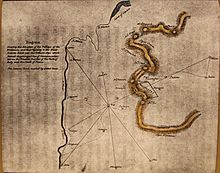Waldensian valleys
As Waldensian valleys , the three Alpine valleys Chisone Valley (Val Cluson), Valle Germanasca and Val Pellice in the Cottian Alps referred to the pre-Reformation Protestant Church Waldensian served from the 16th to the 19th century as a retreat. They are located in the far west of the metropolitan city of Turin near the French border.
In the Middle Ages, Waldensians who were persecuted in France and northern Italy found refuge in these inaccessible valleys. During the Counter Reformation , a large part of this population emigrated to Switzerland and Germany (especially Hesse and Württemberg).
A few years after the Reformation began, the Waldensians made contact with the movement through Geneva; In 1532 they constituted themselves as a separate Protestant church. They were mostly tolerated by the House of Savoy and were useful in defending the border against France. In phases in which Savoy-Piedmont was allied with France, however, the Waldensians were persecuted, particularly cruelly in 1655 and 1686. The latter persecution ended in complete defeat; those who did not submit had to go into exile abroad. Three years later, with the support of major Protestant powers, a small number of them returned as an armed expeditionary force (French: Glorieuse rentrée , Italian: Glorioso rimpatrio ), holed up for months on a ridge near Balsiglia (municipality of Massello , Valle Germanasca, small museum) and fled away there over slopes considered impassable. They were on the verge of being wiped out when a sudden change in political alliances caused Duke Viktor Amadeus II to issue a geographically restricted edict of tolerance.
To this day, the Waldensians celebrate the memory of February 17, 1848, when they received full civil rights through a patent from King Carlo Alberto . Since then the populations have mixed strongly; the Waldensian denomination is now clearly in the majority in the Waldensian valleys compared to the Catholic.
The church language was French until the 20th century, while Occitan was the common language .
The main town of the Waldensians was Torre Pellice ; a historical and ethnographic museum has been located there since the beginning of the 20th century. The historical part of the museum was completely redesigned and modernized in 2019.
literature
- Sabine Bade, Wolfram Mikuteit, Partisan Paths in Piedmont. Places and ways of resistance between Gran Paradiso and Monviso , Querwege Verlag, Konstanz 2012, ISBN 978-3-941585-05-8
Web links
- [de] Foundation Waldensian Cultural Center
- [de] Museo della Balsiglia
- Denis Lachmann (ed.): The Waldensians. A travel guide for the Waldensians in Italy. 2010. [Compilation from various publications, translated into German]
